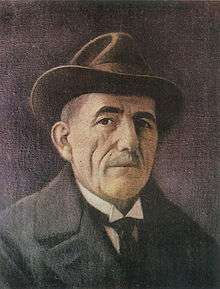Kolë Idromeno
| Kolë Idromeno | |
|---|---|
 Self-portrait (1931) | |
| Born |
Kolë Idromeno 1860 Shkodër, Albania (then Ottoman Empire) |
| Died | 1939 |
| Nationality | Albanian |
| Education | Accademia di Belle Arti di Venezia |
| Known for | Painting, Drawing, Sculpture, Printmaking, Ceramics |
| Notable work | Motra Tone |
Kolë Idromeno (born Nikola Arsen Idromeno, 1860–1939) was an Albanian painter, sculptor, photographer, architect and engineer.
Biography
He was born in Shkodër, where he learned the first elements of photography from Pietro Marubi. Of Cham descent,[1] in 1876 Idromeno stayed for some months at the Accademia di Belle Arti di Venezia, the academy of fine arts of Venice, and then worked in the studio of an Italian painter. When back in Albania (1878), he engaged himself in a number of different activities, working as an architect, sculptor, photographer, scene-painter, engineer and painter. He was the initiator of the first art exhibition in Shkodër (1923) and was represented in the first national art exhibition in Tirana (1931).
He established a very active photographic studio. Idromeno was the first painter to show motion pictures in Albania in 1912. He had kept up a correspondence with the Lumière brothers in Paris.
His most well known work is Motra Tone. He was the first landscape painter in the modern Albanian painting school (Courtyard of a House in Shkodra) and pioneered realistic secular painting. His works were represented in international exhibitions, for example, in Budapest, Austria–Hungary (1900) and New York, United States (1939).
One of his best work, not very popular is the portrait Gjergj Kastriot Skenderbeu. It was painted in 1889. Its owner it is not known, and the painting has never been in public.
His works are held in the Mezuraj Museum, Tirana.[2]
As an architect, Idromeno has carved his name into many well-known objects in Shkodra. The list includes "The Big Cofee Shop" (Albanian: Kafja e Madhe), the Grand Catholic Cathedral, church of Shirokë, first electrical station of the town, Radovan Building, the Prefecture Building, mosque of Parrucë, and most of the residences of villas along the main boulevard in the northern historical district of Shkodra.
He is referred as Michelangelo of Albania.[3]
References
| Wikimedia Commons has media related to Kolë Idromeno. |
- ↑ Nazarko,M. The last war." Familja e Kole Idromenos ishte nga mё tё njohurat e Pargёs sё Çamёrisë... i vendosur nё Shkodёr, ku u martua me Roza Saraçin, nga njё familje qytetare shkodrane... Kola lindi me 15 gusht 1860 dhe vdiq më 12 dhjetor 1939."
- ↑ Mezuraj Museum
- ↑ Fatmira Nikolli (2013-11-22). "Idromeno arkitekt, ja veprat që realizoi" [Idromeno as architect, here are the works he created] (in Albanian). BalkanWeb. Retrieved 2013-11-22.